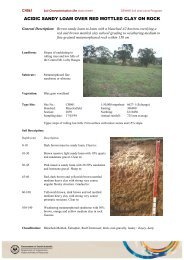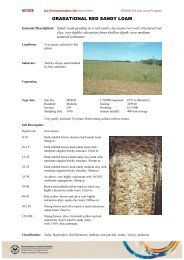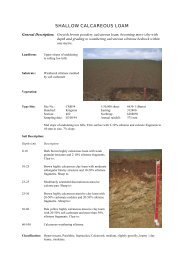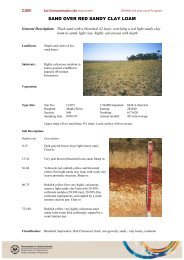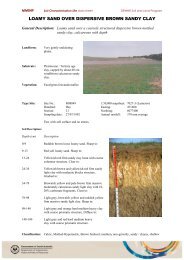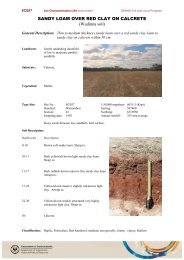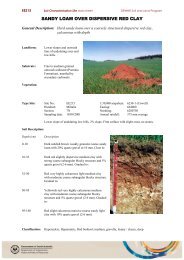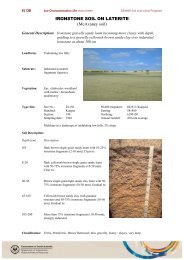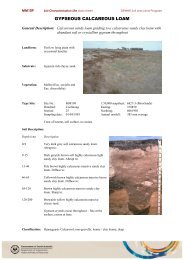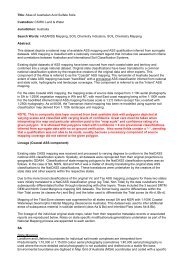Create successful ePaper yourself
Turn your PDF publications into a flip-book with our unique Google optimized e-Paper software.
Exchangeable bases, CEC, and ESPEstimates of exchangeable bases (i.e. Σ(Ca+Mg+Na+K) in cmol/kg), CEC (cmol/kg), and ExchangeableSodium Percentage (ESP) are made for the five layers using the same guidelines for pH. Estimates for Layers2–5 are averages for the complete layer. Method codes describe both the estimation procedure (Table 39)and laboratory procedure – the latter is needed to distinguish between buffered and un-buffered methods(Table 40).Table 39: Estimation method for exchangeable bases, CEC and ESPEstimationMethodDescription1 Estimate based on measurements of exchangeable bases, CEC and ESP forreplicated soil profiles in the land-unit tract2 Estimate based on a single measurement of exchangeable bases, CEC and ESPin the land-unit tract3 Estimate based on direct measurements of similar soils in the same land unittype (e.g. modal profiles)4 Estimate based on direct measurements of similar soils in the region or projectarea5 Estimate based on experience with similar soils (e.g. same taxa in theAustralian Soil Classification but from other regions)Layer-1 Exchangeable bases, CEC, and ESP• In most instances, the estimate applies to the upper 50 mm of the A1 horizon.• If the surface layer is an O horizon, the estimate applies to the upper 50 mm of the underlying Ahorizon.• If the surface layer is an O horizon and there is no underlying A horizon, the estimates refer to the 50mm thick layer directly beneath the O horizon.• If the surface layer is a peat, the estimate applies to its upper 50 mm.• If the A1 horizon is thinner than 50 mm, then the estimate is for the horizon.Exchangeable Bases, CEC, and ESP in Layers 2–5The Exchangeable Bases, CEC, and ESP for these layers are averages. The guidelines on the definition oflayers used for texture apply to Layers 2–5. If no B horizon is present and the sequence consists of an ACprofile, the Layer-3 estimates are taken from the layer 0.20 m directly below the A horizon. Again, theLayer-5 estimate refers to a depth between 1.5–2.0 m. If an R horizon or hard materials (including acalcrete pan, partially weathered rock or saprolite, or other hard materials) occurs at a shallower depth,and this is still below Layer 4, then the Layer-5 estimates apply to the lowest 100 mm in the profile.Otherwise the variable is recorded as missing.55




